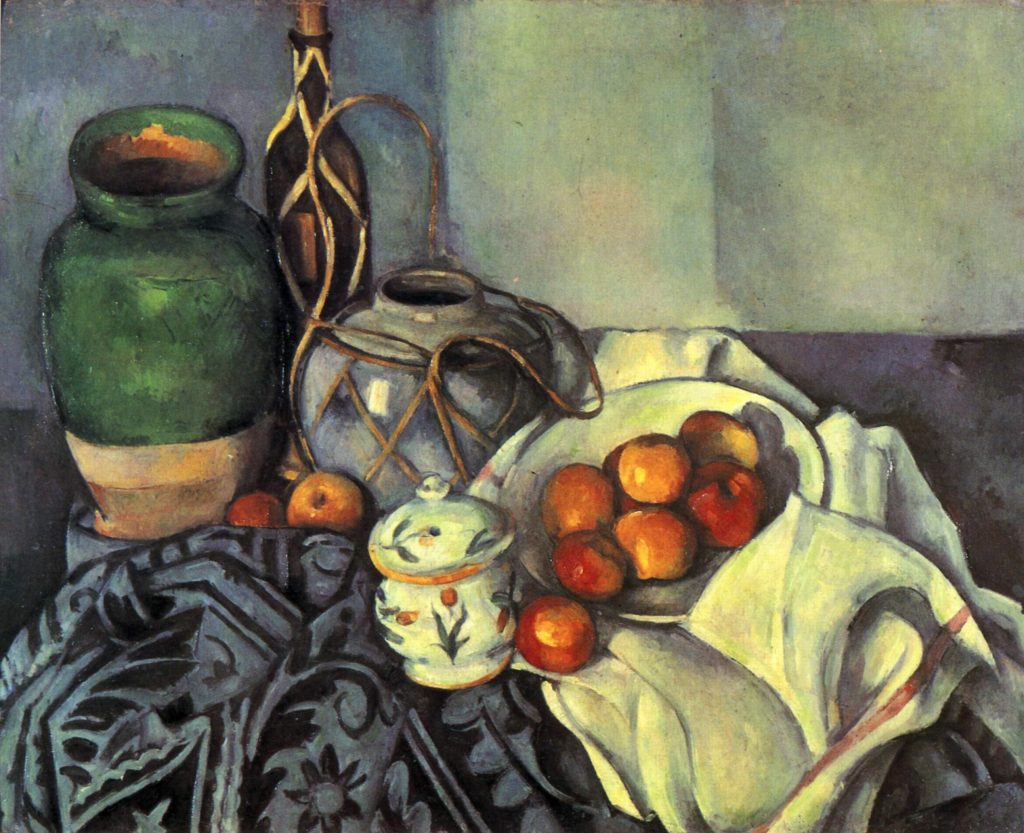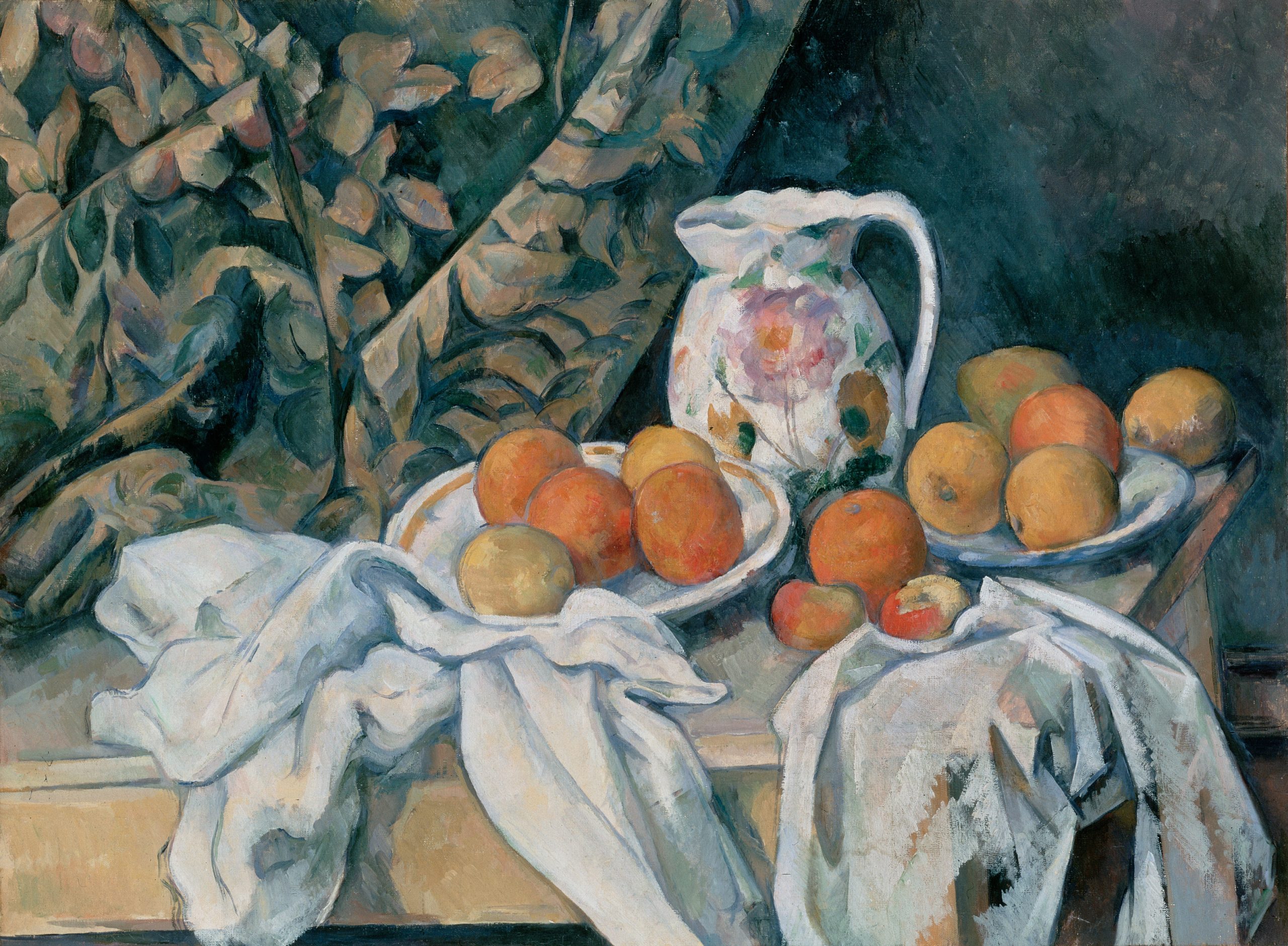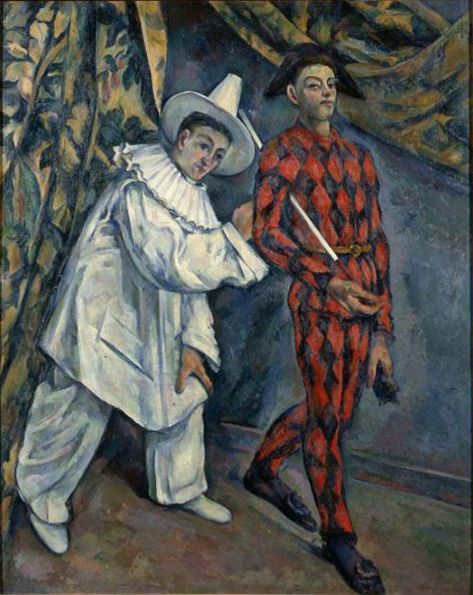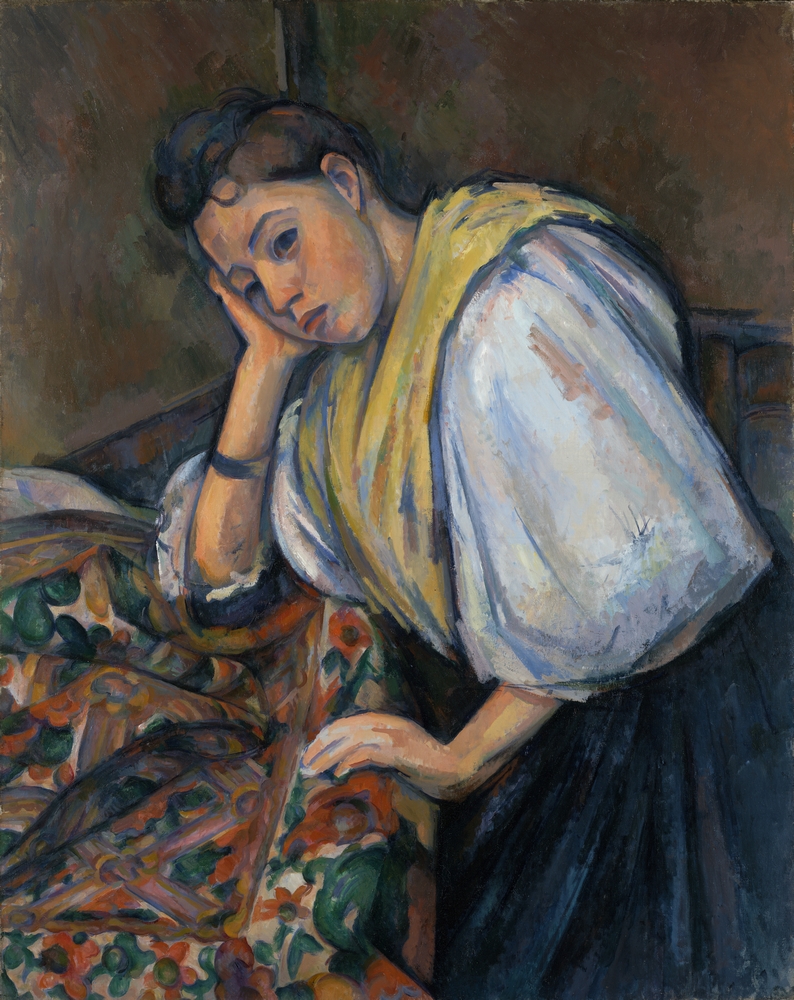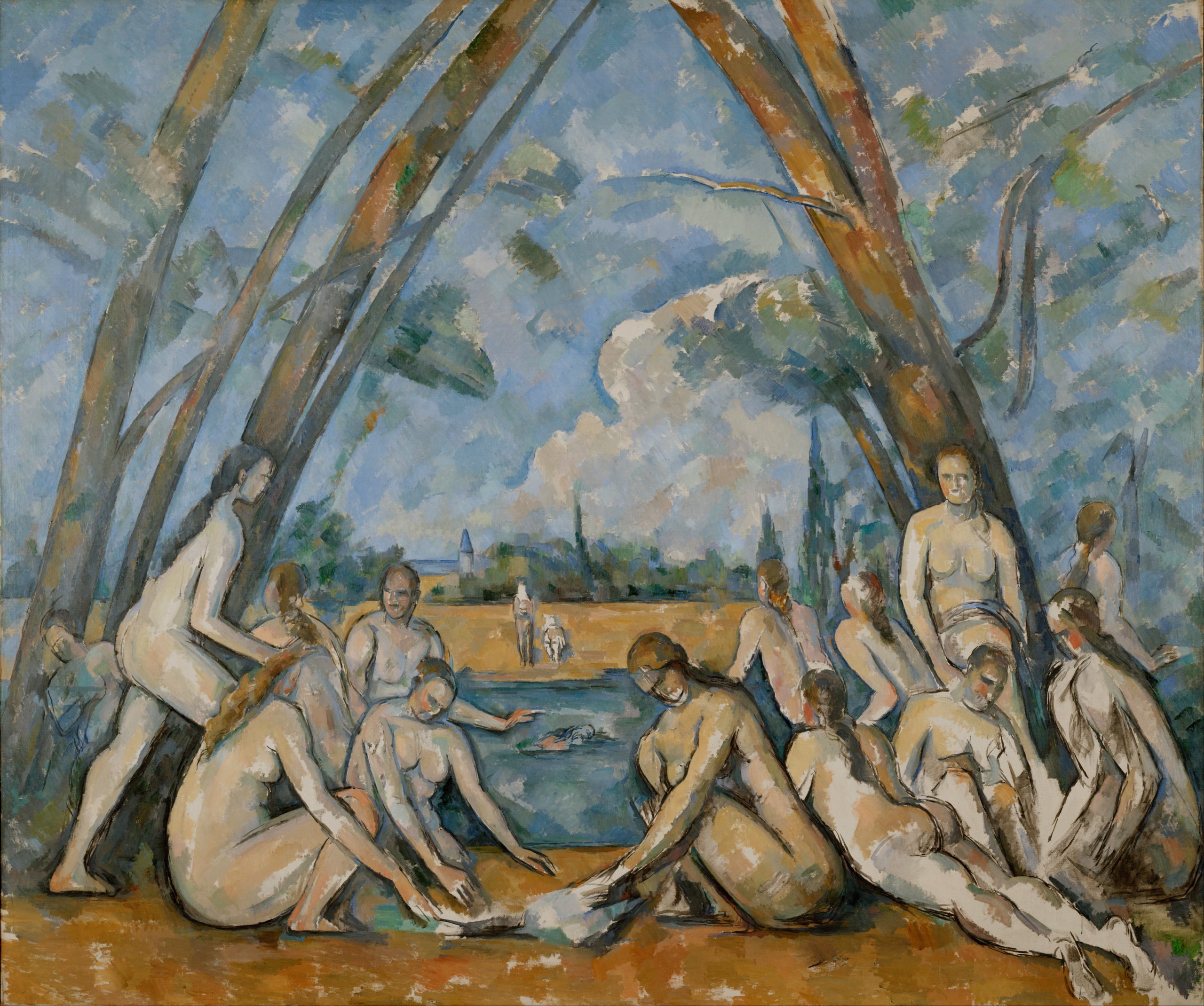Paul Cézanne
Young Italian Woman is in North Lodge Park; Still life with Apples is at Home House on High Street
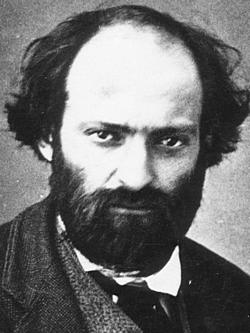
Paul Cézanne (1839 – 1906) was a French artist and Post-Impressionist painter. Cézanne is said to have formed the bridge between late 19th-century Impressionism and early 20th century’s new line of artistic enquiry, Cubism. His work laid the foundations for the transition from the 19th-century style of painting to a new and radically different world of art in the 20th century.
Cézanne’s often repetitive, exploratory brushstrokes are highly characteristic and clearly recognizable. He used planes of colour and small brushstrokes that build up to form complex fields. The paintings convey Cézanne’s intense study of his subjects. Both Matisse and Picasso are said to have remarked that Cézanne “is the father of us all”.
Early years and Family
Paul Cézanne was born on 19 January 1839 in Aix-en-Provence. His father was the co-founder of a banking firm (Banque Cézanne et Cabassol) that prospered throughout the artist’s life, this gave him financial security, unlike many of his artistic contemporaries. His mother was said to be artistic “vivacious and romantic, but quick to take offence”. It was from her that Cézanne got his conception and vision of life. Paul also had two younger sisters.
At the age of ten Cézanne entered the Saint Joseph school in Aix. At 13 Cézanne entered the Collège Bourbon in Aix, where he became friends with Émile Zola, who was in a less advanced class, as well as Baptistin Baille—three friends who came to be known as “Les Trois Inséparables” He stayed there for six years, though in the last two years he was a day scholar. In 1857 aged 18, he began attending the Free Municipal School of Drawing in Aix, where he studied drawing under Joseph Gibert, a Spanish monk. From 1858 to 1861, complying with his father’s wishes, Cézanne attended the law school of the University of Aix, but he also carried on with his drawing lessons.
Going against the his father’s wishes, he fully committed himself to his artistic development and left Aix for Paris in 1861. He was strongly encouraged to make this decision by Zola, who was already living in the capital at the time. Eventually, his father reconciled with Cézanne and supported his choice of career. Cézanne later received an inheritance of 400,000 francs from his father, which rid him of all financial worries
Artistic Style
In Paris, Cézanne met the Impressionist Camille Pissarro. Initially their friendship was that of master and disciple, in which Pissarro exerted a formative influence on the younger artist. Over the course of the following decade their landscape painting excursions together, in Pontoise and Louveciennes, led to a collaborative working relationship between equals.
Cézanne’s early work is often concerned with the figure in the landscape and includes many paintings of groups of large, heavy figures imaginatively painted in the landscape. Later in his career, he became more interested in working from direct observation and gradually developed a light, airy painting style. Nevertheless, in Cézanne’s mature work there is the development of a solidified, almost architectural style of painting. Throughout his life he struggled to develop an authentic observation of the seen world by the most accurate method of representing it in paint that he could find. To do this, he structurally ordered whatever he observed into simple forms and colour planes. His statement “I want to make of impressionism something solid and lasting like the art in the museums”. He stated that he was recreating Poussin “after nature” hoping to unite observation of nature with the permanence of classical composition.
Optical Phenomena
Cézanne was interested in the simplification of naturally occurring forms to their geometric essentials: he wanted to “treat nature in terms of the cylinder, the sphere and the cone” (a tree trunk may be a cylinder, an apple or orange a sphere, for example). Cézanne’s desire to capture the truth of perception led him to explore binocular vision graphically, rendering slightly different, yet simultaneous visual perceptions of the same phenomena to provide the viewer with an experience of depth different from those used in the earlier restrictions of perspective. His interest in new ways of modelling space and volume probably derived from the stereoscopy obsession of his era and from reading Hippolyte Taine’s Berkelean theory of spatial perception.
Exhibitions and Subjects
Cézanne’s paintings were shown in the first exhibition of the Salon des Refusés in 1863, which displayed works not accepted by the jury of the official Paris Salon. The Salon rejected Cézanne’s submissions every year from 1864 to 1869. He continued to submit works to the Salon until 1882. In that year, through the intervention of fellow artist Antoine Guillemet, he exhibited Portrait de M. L. A., probably a portrait of his Father, Reading “L’Événement”, 1866 his first and last successful submission to the Salon.
Before 1895 Cézanne exhibited twice with the Impressionists (at the first Impressionist exhibition in 1874 and the third Impressionist exhibition in 1877). In later years a few paintings were shown at various venues, until 1895, when the Parisian dealer, Ambroise Vollard, gave him his first solo exhibition and continued to promote him successfully in subsequent years. Despite the increasing public recognition and financial success, Cézanne chose to work in increasing artistic isolation, usually painting in the south of France, in his beloved Provence, far from Paris.
He concentrated on a few subjects and was equally proficient in each of these genres: still lifes, portraits, landscapes and studies of bathers. For the last, Cézanne was compelled to design from his imagination, due to a lack of available nude models. Like the landscapes, his portraits were drawn from that which was familiar, so that not only his wife and son but local peasants, children and his art dealer served as subjects. His still lifes are at once decorative in design, painted with thick, flat surfaces, yet with a weight reminiscent of Gustave Courbet. The ‘props’ for his works are still to be found, as he left them, in his studio, in the suburbs of modern Aix.
Opinions and Reputation
His work was not well received among the petty bourgeoisie of Aix, and for many years Cezanne was known only to his impressionist colleagues and to a few younger radical post-impressionist artists, including Vincent van Gogh and Paul Gauguin. During his last years many younger artists traveled to Aix to watch him work and to learn about his methods. But both his style and his theory were mysterious and cryptic; some thought him to be a naive primitive, while to others he was a sophisticated master of technical procedure.
In 1903 Henri Rochefort visited the auction of paintings that had belonged to Zola and wrote a highly critical article entitled “Love for the Ugly”. Rochefort describes how spectators had supposedly experienced laughing fits, when seeing the paintings of “an ultra-impressionist named Cézanne”. The public in Aix was outraged, and for many days, copies of the article appeared on Cézanne’s door-mat with messages asking him to leave the town “he was dishonouring”.
Cezanne’s goal was, in his own mind, never fully attained. He left most of his works unfinished and destroyed many others. He complained of his failure at rendering the human figure, the great figural works of his last years, such as the Large Bathers (c. 1899-1906), show curious distortions that seem to have been dictated by his rigorous system of color modulation. Despite the artist’s own frequent despair, he had synthesized the basic expressive and representational elements of painting in a highly original way. He had attained an almost legendary reputation by the time of his unexpected death at the age of 66.
Death
Cézanne was caught in a storm while painting outside in the field. After more than two hours the storm finally forced him to give up and he decided to go home; but on the way he collapsed. He was taken home by a passing driver. His old housekeeper rubbed his arms and legs to restore the circulation; and he gradually regained consciousness. On the next day, he intended to continue working, but later on he fainted; the model with whom he was working called for help; he was put to bed, and he never left it. He died a few days later, on 22 October 1906 of pneumonia and was buried at the Saint-Pierre Cemetery in his hometown of Aix-en-Provence.


